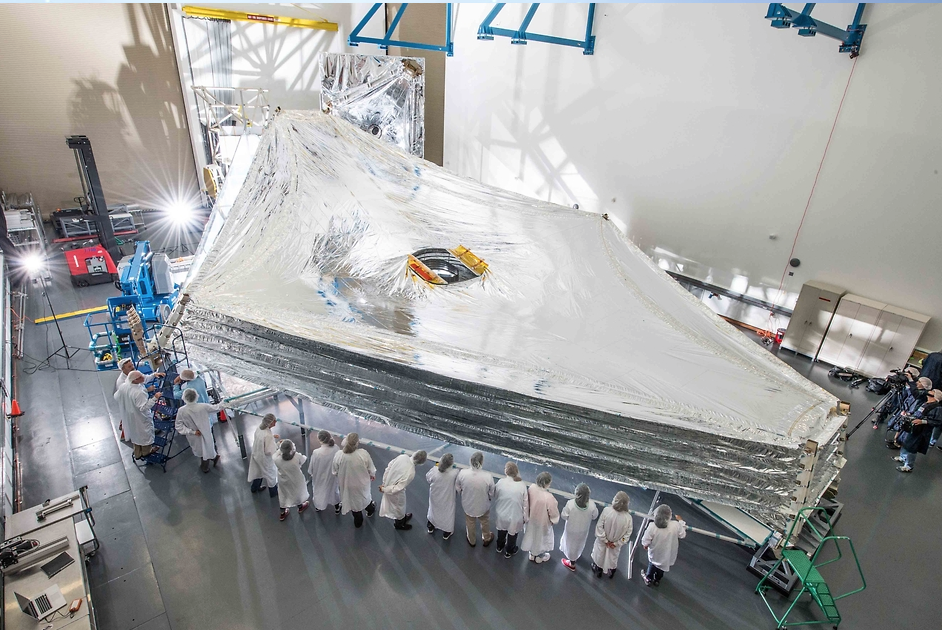[SatNews] This massive parasol is as long as a tennis court, but incredibly light and offers intense protection from the Sun, letting through less than a millionth of the Sun’s heat!
Here on Earth, under the protection of the layers of our atmosphere, we can still find the heat from the Sun sometimes almost unbearable. This is also a problem for space-based telescopes like the James Webb Space Telescope (JWST).
Once in its operational orbit, JWST will be exposed directly to the Sun’s intense glare – not ideal when most of JWST needs to be kept at very cool, infrared-friendly temperatures. To cater for this, the observatory needs to be equipped with a protective parasol.
The kite-shaped piece of foil shown here is the sunshield test unit for JWST. This image captures the first time the deployment of the sunshield was fully and successfully tested, at a cleanroom in the Northrop Grumman facility in Redondo Beach, California, USA, during the first week of July 2014.

The Sunshield on NASA's James Webb Space Telescope is the largest part of the observatory—five layers of thin membrane that must unfurl reliably in space to precise tolerances. Last week, for the first time, engineers stacked and unfurled a full-sized test unit of the Sunshield and it worked perfectly. Here the test unit was stacked and expanded at a cleanroom in the Northrop Grumman facility in Redondo Beach, California. Photo Credit: NASA/Chris Gunn
This sunshield is the largest part of JWST and offers intense protection from the Sun, letting through less than a millionth of the Sun’s heat! This massive parasol is as long as a tennis court, but incredibly light. It is composed of five super-thin membranes that will separate and unfurl into a precise arrangement once the telescope is in space. During launch, this shield will be folded up like an umbrella to fit neatly around the telescope’s mirrors and other instruments within the Ariane 5 rocket fairing.
When unfurled, the sunshield will protect JWST’s ‘cold’ side, where very sensitive infrared instruments are located inside the Integrated Science Instruments Module, maintaining a thermally stable cold environment, around –233 degrees C! In addition to providing a cold environment, the Sunshield provides a thermally stable environment. This stability is essential to maintaining proper alignment of the primary mirror segments as the telescope changes its orientation to the sun.
The Sunshield separates the observatory into a warm sun-facing side and a cold side where the sunshine is blocked from interfering with the sensitive infrared instruments. The infrared instruments need to be kept very cold (under 50 K or -370 degrees F) to operate. The Sunshield protects these sensitive instruments with an effective sun protection factor or SPF of 1,000,000 (suntan lotion generally has an SPF of 8-50).
Thanks to the sunshield, these low temperatures are reached passively, without the help of any active cooling system, by radiating heat into deep space. Just one of JWST's instruments, the Mid-Infrared Instrument (MIRI), will be cooled even further by a dedicated cryogenic cooler, reaching around –266 ºC. Although parts of JWST will reach such low temperatures, the shield will create a thermal barrier so that on JWST’s ‘hot’ side, the spacecraft electronics can work at room temperature.
Unlike its predecessor, the Hubble Space Telescope, JWST does not have a baffle protecting its optics from unwanted incoming light. This makes the sunshield’s role even more important because it will not only block heat, but also unwanted light, allowing JWST to operate to the best of its near-infrared capabilities.
When completed, JWST will be the most powerful space observatory ever built. JWST is an international collaboration between NASA, ESA and the Canadian Space Agency.
For more information about the Webb telescope, visit. For more information on the Webb Sunshield, visit.

